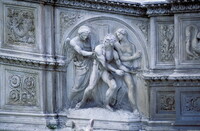| dc.coverage.spatial | Site: Siena, Tuscany, Italy | en_US |
| dc.coverage.temporal | 1409-1419 (creation); copy 1844 (other) | en_US |
| dc.creator | Della Quercia, Jacopo | en_US |
| dc.date | 1409-1419 | en_US |
| dc.date.accessioned | 2013-03-20T14:20:26Z | |
| dc.date.available | 2013-03-20T14:20:26Z | |
| dc.date.issued | 1409-1419 | en_US |
| dc.identifier | 201425 | en_US |
| dc.identifier.other | archrefid: 1113 | en_US |
| dc.identifier.uri | http://hdl.handle.net/1721.3/109187 | |
| dc.description | The fourth niche on the lower right flank; In December 1408 Jacopo, having returned to Siena, signed a contract to build a new fountain in the Piazza del Campo, the central space of the city: the prestigious commission indicates that he was recognized as Siena's leading sculptor. The Fonte Gaia (Siena, Pal. Pub.; the version in the Piazza del Campo is a copy) took its name ('fountain of joy') from the festivity that greeted the arrival of water when it was first brought to this hilltop site in the mid-14th century. The Fonte Gaia was dedicated to the Virgin, traditional protectress of the city, and its iconography was intended to harmonize with and expand on the themes of good government found in the 14th-century frescoes in the Palazzo Pubblico opposite. The fountain as it is now consists of a large rectangular basin, with multiple spouts, surrounded by low walls on three sides, the remaining portion open to allow for direct access to the piazza. The interior of the walls is decorated with shallow niches containing large-scale figures in high relief of the Virgin and Child, flanked by Angels and by the Theological and Cardinal Virtues and Wisdom, plus scenes of the Creation of Adam and the Expulsion from the Garden and at the corners, as originally planned, the Rhea Silvia and the Acca Larentia (the real and adopted mothers of the twins Romulus and Remus, legendary founders of Siena). These are among the earliest free-standing nude female figures of the Renaissance. Source: Grove Art Online; http://www.groveart.com/ (accessed 1/29/2008) | en_US |
| dc.format.medium | marble | en_US |
| dc.rights | © Scott Gilchrist, Archivision, Inc. | en_US |
| dc.subject | allegorical | en_US |
| dc.subject | architectural exteriors | en_US |
| dc.subject | mythology (Classical) | en_US |
| dc.subject | New Testament | en_US |
| dc.subject | Mary, Blessed Virgin, Saint | en_US |
| dc.subject | Renaissance | en_US |
| dc.title | Fonte Gaia | en_US |
| dc.title.alternative | Fountain of Joy | en_US |
| dc.type | image | en_US |
| dc.rights.access | Licensed for educational and research use by the MIT community only | en_US |
| dc.identifier.vendorcode | 1A2-I-S-FG-B11 | en_US |
| vra.culturalContext | Italian | en_US |
| vra.technique | carving (processes) construction (assembling) | en_US |
| vra.worktype | fountain | en_US |
| dc.contributor.display | Jacopo della Quercia (Italian sculptor, ca.1372-1438) | en_US |


